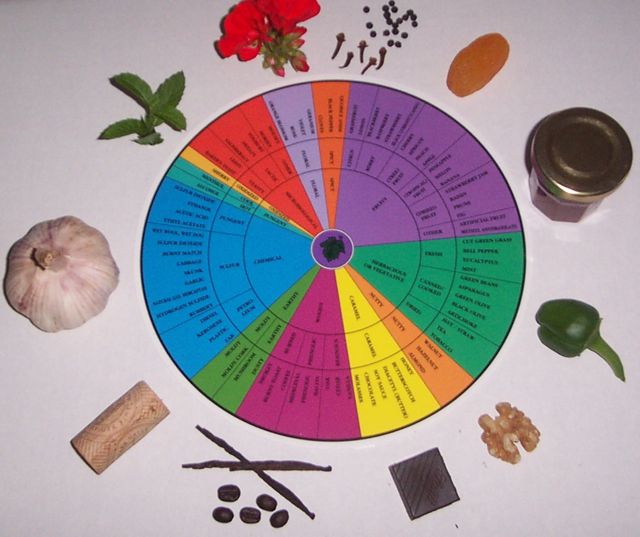Make your own wine aroma kit
Make your own wine aroma kit for practicing wine aroma description whenever you need to. You just need a base wine, different produce, spices or materials, and of course some time to plan ahead. The aroma references will have to be used within the next few days of preparation.
I found training for wine aroma identification more efficient when aromas are presented in a base wine, so to mimic a real wine tasting situation. I also found through my research that the training efficiency was higher when references were real products (e.g. real fruit versus an aromatic composition) or were real wines with distinct characters (see Sulmont et al, 1999).
Advice to make your own wine aroma kit
Select a base wine
How to choose the base wine? A base wine is by definition neutral, without faults, without strong aromas, tastes or mouthfeels. The best base wine I found for creating my wine aroma kits are in bag in a box, which mean you also have a large volume of the same batch to play with.
- Prepare these wine references directly in a wine glass or in an hermetic container that you can store in the fridge if you don’t plan to use the aroma reference right away.
Below are some recipes for wine aroma references, borrowed from Dr. Ann Noble. Indeed, these references are a good complement to the wine aroma wheel.
Recipes for a homemade wine aroma kit
White wine common aromas
in 1 oz neutral white wine
- Asparagus: several drops of brine of canned asparagus
- Bell Pepper: tiny piece of bell pepper; don’t leave them in for too long
- Vanilla: Drop of vanilla extract
- Clove: One clove
- Citrus: ~ 1 teaspoon of fresh orange and grapefruit juice
- Peach: several teaspoons of peach or apricot puree or juice
- Pineapple: 1 teaspoon juice
- Honey: 1 – 2 Tablespoons
Red wine common aromas
in 1 oz neutral red wine
- Asparagus: several drops of brine of canned asparagus
- Bell Pepper: tiny piece of bell pepper
- Vanilla: drop of vanilla extract
- Clove: one clove
- Soy sauce: few drops, great for older red wines
- Berry: Fresh/frozen berries and/or jams
- Berry jam: 1-3 tablespoons strawberry jam
- Black pepper: few grains black pepper
- Anise, black licorice: use few drops of anise extract
Sparkling wine particular aromas
In 1 oz neutral white still wine
- Lime: a few drops of Rose’s lime juice or squeezed lime juice
- Apple: Sniff freshly cut apple
- Toasted hazelnuts: Crushed nuts alone
- Sour cream/yogurt: 1Tbsp. in empty glass
- Yeasty: 1 Tsp of Vegemite® or Marmite®)
- Cherry/strawberry: few drops of flavored juices or extracts
- Nutmeg: few grains
- Caramel: crush one Kraft® caramel
- Vanilla: as for table wines
Wine defects
In 1 oz neutral white or red wine
- Moldy Cork: the BEST standard is the actual example of the defect. Save a spoiled wine which has a moldy odor, produced by TCA (trichloroanisole).
You can freeze the cork-tainted wine for future reference so that it won’t oxidized.
- Oxidation: a few drops of sherry
- Volatile acidity (VA) A few drops vinegar
- Sulfur:
H2S Hydrogen sulfide, boiled egg or black sand from Japanese food store
Ethyl mercaptan: Smell of natural gas (tell people to experiment on their own
carefully.
S02 Sulfur dioxideDried apricots (which were treated with sulfite)
Caution: Many asthmatics are very sensitive to it!
- Brettanomyces is a wild yeast found in some wine: a drop of creosote or add a piece of old fashioned Band-Aid to create a horsy, sweaty saddle, barnyard smell
Sulmont C., Lesschaeve I., Sauvageot F. and Issanchou S. (1999). Comparative training procedures to learn odor descriptors. Effects on profiling performance. Journal of Sensory Studies. 14 467-490.
DOI: 10.1111/j.1745-459X.1999.tb00128.x
Home > Wine Tasting Kit > Wine Aroma Kit > Make Your Own Kit


